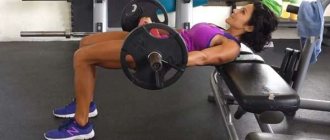Is it possible to do pull-ups every day?
Theoretically, you can do pull-ups every day. But practically the question arises about the advisability of such a load.
The fact is that all plastic and energetic processes of supercompensation, that is, growth and improvement of results, occur in the body during the period of rest from physical activity.
Training is only half the battle. The second half is a complete restoration of muscles and the whole body.
This scheme works regardless of what motor quality you want to develop. Be it muscle mass, strength, endurance or relief work.
BRIEFLY ON THE TOPIC:
Rapid growth in results is the right combination of training frequency and rest after it.
Let's look at these options for different purposes.
Pull-ups for endurance
When developing endurance on the crossbar, use your own body weight.
It is believed that after endurance training, the human body recovers within a day.
Classic exercises for developing general endurance are:
- walking
- run
- a ride on the bicycle
- swimming
These are regular cardio exercises where the body functions in an aerobic mode.
Their standard duration is 40-60 minutes. In this case, the process continues continuously. During this time, the muscles contract thousands of times.
Pull-ups on the horizontal bar do not involve such work.
Here we are not talking about general endurance, but about strength endurance - the ability to perform strength work for a long time.
Therefore, the recovery time for muscles and the body as a whole will differ.
A suitable frequency for developing strength endurance on the horizontal bar is considered to be training every other day. That is, 3-4 times a week.
The same rule applies to terrain training. The optimal frequency of training here is 2-3 times per weekly cycle.
How to increase your pull-ups with extra weight
If your result is in the region of 32 kilograms of additional weight for 8 repetitions or more.
It's better for you to train after 4 days. This frequency must be adhered to for maximum progress. Working sets around four. Let's say: - Warm-up with body weight 12 repetitions - First set +16 kilograms 8 times - Second set +32 kilograms for 10 repetitions - Third set +32 for 6-8 repetitions - Fourth set +32 kilograms for 2-4 repetitions - Final set with your own weight to the maximum. 5 minutes rest between sets.
Match your working weight to your workouts, but the principle remains the same. This is such a simple and at the same time effective training program. There are enough methods to increase your pull-ups on the horizontal bar. At its core, this is a properly constructed process and recovery.
Pull-ups for muscle growth
When working to gain mass, the frequency of training depends on the speed of muscle recovery after strength training.
- The optimal frequency is 1-2 times a week
- Rep range 8-12 times
- Number of approaches 3-4
If you can perform the exercise for more than 12 repetitions, then you need to increase the load with additional weights.
Usually they wear a special belt, onto which some kind of load is attached (a disc from a barbell, a weight, etc.).
The fact is that the latissimus dorsi is a large muscle mass. It is these muscles that bear the main load when doing pull-ups.
The average recovery rate for large muscle groups after strength exposure is 4-5 days. Therefore, it is permissible to do power pull-ups 2 times a week.
But very often this load regime for the lats is excessive. This results in a halt in progress in both strength and growth.
In this case, it is more rational to limit yourself to 1 workout per week.
This recommendation is more suitable for experienced athletes.
Their own muscle mass and the weights used are quite significant. Therefore, muscle recovery takes longer.
What benefits can you get from doing pull-ups every day?
Pull-ups are one of the types of exercises that use a person’s own weight. During classes, several muscle groups necessary for warming up work. Pull-ups have their own rules and technique.
Minimum number of pull-ups per workout
Pull-ups just seem to be not very effective exercises for pumping up muscles. Regardless of the grip type, they are important for increasing endurance and are considered one of the least damaging exercises. They also keep the body in shape when it is not possible to exercise fully.
A positive result from training does not depend on the frequency and duration of exercise, but on the correct execution of each pull-up.
The frequency of exercises and the frequency of approaches for each athlete are selected individually. His physical fitness is largely taken into account. But even a trained person does not need to perform more than 10 repetitions of pull-ups in one approach. Otherwise, you can get overstrained muscles and stretched connective tissue. The most popular scheme is 50 exercises in several sessions.
Ten repetitions is the best option. Even after this amount of exercise, the muscles will receive the necessary load and need to be restored. As you know, it is during rest that muscle growth occurs. Therefore, as long as your back, arms and shoulders hurt, you should not do exercises.
The frequency also depends on the technique used. The more difficult it is, the longer the break between classes.
What pull-up exercises can do for you
At first glance, the exercise is very simple, but effective. It is the basis for beginner athletes and those who want to have sculpted arms and a strong back. Pull-ups have great potential; they significantly improve the physical qualities of an athlete.
With the help of classes, the following are worked out: the rhomboid, teres and latissimus dorsi muscles, biceps, etc. There is also a load on the abdominal muscles, which tense to hold the body in an upright position.
The benefits of pull-ups are visible only if you breathe correctly and perform the exercise technique. Even small but regular exercise leads to the following results:
- increasing endurance;
- strengthening the hands, joints and ligaments;
- weight gain;
- makes the grip stronger;
- formation of muscle relief;
- improving the functioning of the heart and blood vessels;
- getting rid of excess weight;
- corrects the figure.
Also, exercises on the crossbar allow you to maintain your spine in a functional state. A healthy spine is the key to a healthy body. Classic pull-ups strengthen the muscle corset in the back area, training the paravertebral muscles. As a result, the spinal column is better supported.
Correct technique prevents the development of scoliosis and osteochondrosis. The usual hanging on the horizontal bar helps to straighten your posture. It is performed passively, without additional swinging.
Exercises on the horizontal bar can be performed with different grips, but they are all equally beneficial for the back.
If the exercise is performed technically incorrectly, it can cause harm and injury to the spine.
Knowing some nuances, you can achieve the desired effect:
- fast descent and slow ascent help build mass;
- slow descent and rapid ascent build muscle and strength;
- quick ascent and quick descent promote good flexibility and stretching.
To prevent the muscles from becoming overtired, the load should increase gradually. Otherwise, tired muscles will not perform full loads. Muscles that are exhausted by daily training are most susceptible to injury. The best option is no more than 3 workouts per week. The more time they have to recover, the more efficiently they work.
Regular exercise over several years will allow you to do pull-ups with one arm and perform exercises using weights. However, you should not neglect the restrictions on performing these exercises. It is necessary to study all contraindications.
Daily workouts as exercise
Doing pull-ups every day as exercise or warm-up is best.
The purpose of morning exercises is to help the body “wake up” and comfortably enter work mode.
Exercises should be, on the one hand, easy and accessible. And on the other hand, complex, so as to cover the maximum number of muscles in a minimum time.
During pull-ups, several joints and muscle groups work simultaneously. And according to this parameter it fits perfectly.
Well, the ease of implementation depends on the level of preparation. If you do 15-20 pull-ups with a horizontal bar and calmly, then use this exercise as an element of daily exercise.
In this case, a load of 50% of the maximum is used.
For example, your record is 20 repetitions. Then, to warm up, you only do 10 times. In this mode, you can perform this exercise daily.
Well, use the maximum load on the crossbar during the main workout.
Muscles involved in different types of grip
You need to study information about what types of pull-ups on the horizontal bar exist. Depending on the exercise chosen, different muscle groups will be involved. This point must be taken into account in order to correctly develop a scheme for further classes.
Types of pull-ups on the horizontal bar
Wide behind the head and towards the chest
Starting the topic of which muscles work on the horizontal bar when pulling up to the chest, it is worth noting that this exercise is considered one of the most useful. The emphasis when performing it is on the following groups of muscle tissue:
- round steam rooms;
- trapezoidal.
True, not everyone can perform the exercise correctly. If you do not adhere to the technique, the desired result is simply not achieved. You need to do the following:
- Grasp the horizontal bar with approximately the same grip as when performing a barbell bench press.
- The crossbar is grasped from above with your thumbs.
- When bringing the shoulder blades together, a pull-up is performed, but the biceps remain relaxed. The upper part of the chest needs to touch the projectile.
- Literally linger at the top for seconds and return to the original position.
Push-ups on the horizontal bar with a wide head grip are considered dangerous. To avoid problems, the exercise is performed strictly according to the rules. It is made using the following technology:
- The grip width is exactly the same as in the previous case.
- When pulling up, the back does not bend.
- The legs are straightened and placed in line with the torso.
- Deflection of the elbow joints back is unacceptable. They are located straight down.
It’s worth figuring out which muscles work when doing pull-ups on the horizontal bar. The widest muscles (center and top), round pairs are involved. In addition, the athlete also pumps the trapezius during the training.
If you perform the exercise on the horizontal bar with a wide grip on the head carelessly or too often, there is a risk of injury. They can also be provoked by very weak joint mobility in the shoulder area.
Middle top and bottom
The method of pulling up on a horizontal bar with a medium overhand grip is considered classic. This exercise develops the muscle tissue of the back, shoulders and biceps. It is performed according to the following scheme:
- Hands on the bar are shoulder-width apart.
- The athlete sags with his legs crossed and his back slightly arched.
- You need to pull yourself up, squeezing your shoulder blades together and touching your chest to the apparatus.
- When returning to the lowest point, the arms are fully straightened.
Push-ups with a medium grip from below are a little easier. The maximum tension is observed in the biceps area. The muscles in the back area also become tense when tightening. Hands on the bar are shoulder-width apart, but the grip is with your palms facing you. When lifting to the top point, the shoulders are pulled back and down.
Narrow grip
The narrow grip deserves special attention. In this case, not just one muscle group is involved, but many. The athlete tenses the lower lats, biceps, as well as the shoulder and serratus muscle tissues. The exercise involves the following actions:
- The athlete hangs on the horizontal bar. His hands are located fairly close to each other, but not excessively.
- The back sags a little.
- Pull-ups are performed by touching the bottom of the chest to the bar.
When doing push-ups you need to be extremely careful. It is extremely important to ensure that as you lift, your shoulders are pulled back and your shoulder blades are retracted. When you reach the top point, you should bend your back more strongly.
Parallel grip
Narrow grip
Neutral along the crossbar
During this exercise, the athlete uses several muscle groups. Not only the lower lats are tense, but also the shoulder and serratus muscles. The training takes place according to the following scheme:
- The athlete grabs the apparatus in such a way that one of the fists is located in front of the other.
- When lifting, the back actively bends.
- You need to touch the horizontal bar with your lower chest.
- When the top point is reached, the head is moved to the side. And from time to time to another.
With each approach, you must definitely change the position of your hands. Otherwise, the load on the muscles will be uneven.
Partial pull-ups
The exercise is a kind of biceps curl that uses a bar. This is exactly how many famous bodybuilders prefer to swing. The maximum tension is observed in the biceps brachii muscle.
When performing, you need to grab the projectile with a reverse medium grip and rise to halfway. In this position, the body is fixed strictly at a right angle to the floor. The arms are bent. The athlete makes every effort to pull his collarbone towards the apparatus.











